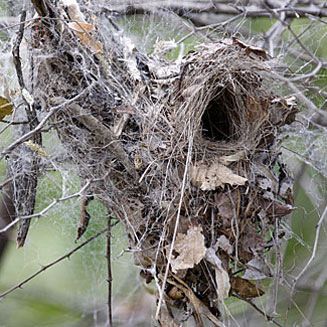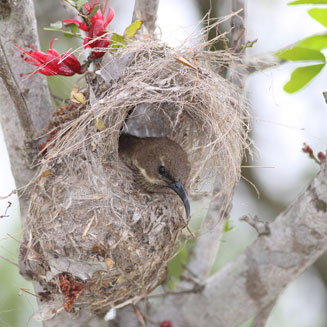|
Chalcomitra senegalensis
(Scarlet-chested sunbird)
[= Nectarinia senegalensis]
Rooiborssuikerbekkie [Afrikaans]; Kalyambya (generic term for
sunbird) [Kwangali]; Dzonya, Tsodzo (both are generic names for sunbird)
[Shona]; Nwapyopyamhanya (generic term for sunbird) [Tsonga]; Senwabolôpe,
Talętalę (generic terms for sunbirds) [Tswana]; Roodborst-honingzuiger
[Dutch]; Souimanga ŕ poitrine rouge [French]; Rotbrust-glanzköpfchen,
Rotbrust-nektarvogel [German]; Beija-flor-de-peito-escarlate [Portuguese]
Life
> Eukaryotes >
Opisthokonta
> Metazoa (animals) >
Bilateria >
Deuterostomia > Chordata >
Craniata > Vertebrata (vertebrates) > Gnathostomata (jawed
vertebrates) > Teleostomi (teleost fish) > Osteichthyes (bony fish) > Class:
Sarcopterygii (lobe-finned
fish) > Stegocephalia (terrestrial
vertebrates) > Tetrapoda
(four-legged vertebrates) > Reptiliomorpha > Amniota >
Reptilia (reptiles) >
Romeriida > Diapsida > Archosauromorpha > Archosauria >
Dinosauria
(dinosaurs) > Saurischia > Theropoda (bipedal predatory dinosaurs) >
Coelurosauria > Maniraptora > Aves
(birds) >
Order: Passeriformes > Family: Nectariniidae
Distribution and habitat
Occurs across sub-Saharan Africa from Senegal to Eritrea,
absent from the lowland forest of central DRC, south to southern Africa. Here it
is common in Mozambique, Zimbabwe, eastern South Africa and Swaziland, but
scarce further west in northern Botswana and Namibia. It generally prefers mixed
open savanna woodland, especially fragmented miombo (Brachystegia)
woodland, thornveld and coastal scrub. It has adapted well to the changes of
habitat caused by humans, as it is common in parks and well-wooded gardens.
|
 |
|
Distribution of Scarlet-chested sunbird in southern Africa,
based on statistical smoothing of the records from first SA Bird Atlas
Project (©
Animal Demography unit, University of
Cape Town; smoothing by Birgit Erni and Francesca Little). Colours range
from dark blue (most common) through to yellow (least common).
See here for the latest distribution
from the SABAP2. |
Brood parasites
It has been recorded as host of the
Klaas's cuckoo.
Food
It eats nectar and arthropods, hawking insects aerially or
plucking prey from the ground. The following food items have been recorded
in its diet:
- Nectar
- Erythrina (coral-trees)
- Leonotis (wild daggas)
- Loranthaceae (mistletoes)
- Schotia
- Kniphofia (torch lilies)
- Aloe
- Crotalaria
- Callistemon viminalis (Australian bottlebrush)
- Tecoma capensis (Cape-honeysuckle)
- Acrocarpus
- Dalbergia nitidula (Purplewood flat-bean)
- Cordyla africana (Wild-mango)
- Arthropods
Breeding
- The nest (see image below) is built solely by the female in about 3-6
days, consisting of a thick-walled, pear-shaped oval structure built of dry
grass, weed stems, dead leaves and bark bound together with spider web, with
a side entrance covered by a small hood of dried grass inflorescences. The
exterior is often decorated with lichen and dead leaves, while the interior
is usually lined with hair, plant down and feathers. It is typically
securely attached to a branch of a leafy tree, often near an active wasps
nest, water body and/or a building.
 |
 |
|
Scarlet-chested sunbird nest, Phabeni Gate area,
Kruger Park, South Africa. [photo Warwick Tarboton ©] |
Scarlet-chested sunbird female in
nest, KwaZulu-Natal, South Africa. [photo
Johan van
Rensburg ©] |
- Egg-laying season is year round, peaking from October-January.
- It lays 1-3, usually 2 eggs, which are incubated solely by the female
for about 13-15 days.
- The chicks are fed by both adults, leaving the nest after about 15-20
days, after which they remain dependent on their parents for 8 weeks longer.
Threats
Not threatened, in fact it has actually benefited from the
fragmentation of miombo (Brachystegia) woodland in Zimbabwe, unlike many
other species such as the Western
violet-backed sunbird.
References
-
Hockey PAR, Dean WRJ and Ryan PG 2005. Roberts
- Birds of southern Africa, VIIth ed. The Trustees of the John Voelcker
Bird Book Fund, Cape Town.
|
